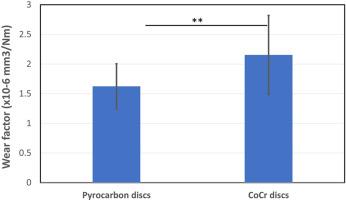超高分子量聚乙烯与热碳摩擦产生的磨损明显低于与钴铬摩擦产生的磨损
IF 3.5
2区 医学
Q2 ENGINEERING, BIOMEDICAL
Journal of the Mechanical Behavior of Biomedical Materials
Pub Date : 2024-10-09
DOI:10.1016/j.jmbbm.2024.106768
引用次数: 0
摘要
关节置换的历史可以归结为一场减少磨损的战斗。事实证明,热碳是一种低磨损材料,但与超高分子量聚乙烯(UHMWPE)台面相比,能否实现低磨损呢?为了研究这个问题,我们使用了一台经过临床验证的 50 工位磨损筛选机。其中一半工位测试超高分子量聚乙烯(UHMWPE)栓与热碳盘的摩擦情况,另一半工位测试超高分子量聚乙烯(UHMWPE)栓与钴铬(CoCr)盘的摩擦情况。试验台以 1Hz 的频率运行,标称接触应力为 2.07 兆帕,测试周期为 500 万次。测试中使用了仿生物润滑剂,每 50 万次循环更换一次。测试结束时,超高分子量聚乙烯销钉与热碳酸酯圆盘摩擦后的磨损量与超高分子量聚乙烯销钉与钴铬圆盘摩擦后的磨损量相比有显著统计学意义(p ≤ 0.01)。测试结束后对圆盘进行的分析表明,与钴铬圆盘相比,热碳圆盘上的磷脂附着力更大。反过来,热碳圆盘上附着的超高分子量聚乙烯也远远少于钴铬圆盘。基于这些证据,我们认为与 CoCr 表面相比,热碳表面可减少 UHMWPE 的粘附磨损。此外,在测试结束时,发现钴铬盘明显比热碳盘粗糙。因此,热碳表面比 CoCr 更光滑,这可能意味着与 CoCr 相比,UHMWPE 的磨料磨损更少。本文章由计算机程序翻译,如有差异,请以英文原文为准。

Significantly less wear of UHMWPE rubbing against pyrocarbon than against CoCr
The history of joint replacement can be framed as a battle to reduce wear. Pyrocarbon has been shown to be a low wear material, but can low wear against an ultra high molecular weight polyethylene (UHMWPE) counterface be achieved? To investigate this research question, a 50-station, clinically validated wear screening machine was used. Half the stations tested UHMWPE pins against pyrocarbon discs, and half the stations tested UHMWPE pins against cobalt chromium (CoCr) discs. The test rig ran at 1Hz, the nominal contact stress was 2.07 MPa, and testing ran to 5 million cycles. A biomimetic lubricant was used, it was replaced every 500,000 cycles. At the end of testing, the UHMWPE pins rubbing against pyrocarbon discs had a statistically significant reduced wear, compared with the UHMWPE pins rubbing against CoCr discs (p ≤ 0.01). Analysis of the discs at the end of testing showed greater adherence of phospholipids on the pyrocarbon discs than the CoCr discs. In turn, it was also seen that far less UHMWPE was attached to the pyrocarbon discs than to the CoCr discs. Based on this evidence, it is suggested that pyrocarbon surfaces are associated with reduced adhesive wear of UHMWPE compared with CoCr surfaces. In addition, at the end of testing, the CoCr discs were found to be significantly rougher than the pyrocarbon discs. Therefore, pyrocarbon maintained a smoother surface than CoCr, likely meaning that abrasive wear of UHMWPE was reduced compared with CoCr.
求助全文
通过发布文献求助,成功后即可免费获取论文全文。
去求助
来源期刊

Journal of the Mechanical Behavior of Biomedical Materials
工程技术-材料科学:生物材料
CiteScore
7.20
自引率
7.70%
发文量
505
审稿时长
46 days
期刊介绍:
The Journal of the Mechanical Behavior of Biomedical Materials is concerned with the mechanical deformation, damage and failure under applied forces, of biological material (at the tissue, cellular and molecular levels) and of biomaterials, i.e. those materials which are designed to mimic or replace biological materials.
The primary focus of the journal is the synthesis of materials science, biology, and medical and dental science. Reports of fundamental scientific investigations are welcome, as are articles concerned with the practical application of materials in medical devices. Both experimental and theoretical work is of interest; theoretical papers will normally include comparison of predictions with experimental data, though we recognize that this may not always be appropriate. The journal also publishes technical notes concerned with emerging experimental or theoretical techniques, letters to the editor and, by invitation, review articles and papers describing existing techniques for the benefit of an interdisciplinary readership.
 求助内容:
求助内容: 应助结果提醒方式:
应助结果提醒方式:


